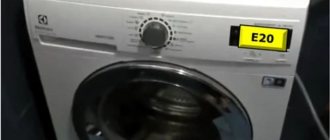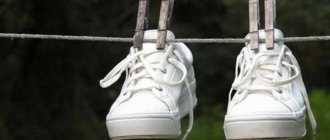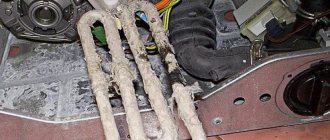Many of us I'm familiar with the problem of socks disappearing after washing in the washing machine.. Many different reasons for this phenomenon and versions of the possible location of these wardrobe items have been put forward. One thing is certain: if the sock was placed in such a unit, it remained in it.
Socks lost in this way can be found if you know where to look for the loss most appropriately. Let's figure out where the socks disappear (“go”).
How to get a sock out of the washing machine if it's stuck
Clogging the washing machine with foreign objects is a fairly common situation. Any small objects can “go inside and not return” - be it an accidentally torn off button, a forgotten handkerchief, or anything else. Most often, it is socks that “go missing” in it - each of us at least once in our lives put a pair in the machine, but only took one out. Therefore, everyone should know how to get socks out of the washing machine on their own without damaging it.
How to dry socks quickly
It is better to dry socks on a clothesline and with good air circulation. But constant drying on various dryers or a radiator depletes fibers and threads. Wool products are laid out and dried on a clean horizontal surface.
If you need socks urgently, there are several ways to express dry them:
- wrapped in cotton cloth, they can be ironed by heating the iron to the maximum temperature;
- The fan will help dry wet products by securing them to the propeller protective grille;
- You can also use a hairdryer by placing a sock over the nozzle and turning on the hot air supply.
Consequences of clogging
Clogging household appliances with a foreign object does not bode well. Very often, such blockages cause obstruction of the drain pipe and lead to the fact that the apartment may be flooded. In addition, individual parts, such as a drum, may be damaged if the sock prevents it from functioning normally.
Even if you are not sure that you started to wash exactly 2 socks, it is better to play it safe and make sure that it did not get stuck inside. Caution will help you maintain the integrity and performance of your expensive equipment.
How to stop the machine
If you suspect that something has gone wrong, unplugging the cord is not the best solution. Such an action may cause a breakdown of the control module or the machine will remember the procedure being performed and return to it as soon as it is connected to the network again.
To emergency stop the washing machine, you need to press the “Start/Pause” button, then press it again and hold for about 5 seconds. After this, the process of stopping the machine will begin. If the pump fails to drain the water, then you need to do it yourself - through the “emergency” drain (it is a small hose located next to the filter) or through the filter itself. Draining the water is mandatory, because otherwise you will not be able to open the machine.
Where to look for a sock
Where do socks most often go in the washing machine?
- Soft, sealing cuff on the hatch door;
- Tank bottom;
- Pipes;
- Drain filter or snail;
- Drum.
You can only find a stuck sock using your hands. Therefore, probing the elements of the washing machine can take quite a long time.
How can you tell if a bone has gotten into your car?
A metal object inside iron containers can be heard when the drum rotates. Pay attention to clanging, grinding, knocking or any unusual sound when the device is operating.
A sign that laundry accessories have penetrated into the washing machine is a mode failure, the machine turns off, or a leak. If the equipment begins to leak water, you should stop the cycle and unload the clothes. Next, the car is inspected for visible damage and the linen is checked.
When the cause of the pit is confirmed, it should be immediately removed from the bowels of the household appliance.
Where to look first
As already mentioned, it’s better to start your search with the simplest thing. During this procedure, you do not have to disconnect the automatic machine from the power supply: open the hatch door and look under the edge of the seal. An object could get stuck in the gap that is located there. If you notice a bulge or edge of the sock, carefully remove it so as not to damage the seal.
If the cavity under the seal is empty, you need to check the drain filter. It is located in the front of the automatic machine, under the false panel or small hatch. Place a cloth under the drain, onto which the remaining liquid from the machine will drain, and unscrew it. Look for a sock in the filter opening and in the drain hose - socks often get caught there under the influence of strong water pressure.
How to deal with mismatched socks
Why is the number of socks taken out of the washing machine almost always an odd number, and why does spending a lot of time sorting socks into pairs end up with a pile of “singles”? Where do the latter go? This question is asked by many people around the world.
The mysterious disappearance of socks has already given rise to a lot of myths. If you believe them, then:
- socks are stolen by an invisible animal that lives in every apartment - the gypsy sock eater. If he does not have time to finish one sock from a pair, he gnaws holes in it;
- washing machines feed on socks, thus charging for their work;
- brownies steal socks;
- sock manufacturers have entered into a secret worldwide conspiracy and, in order to increase demand for their products, make some socks water-soluble;
- In the apartment there is a portal to a parallel Universe inhabited by socks.
There are a lot of such fantastic explanations. This makes it possible to treat the problem of lonely socks with humor, but does not help solve the problem. But what is really happening?
Washing machines may indeed be the culprit behind the disappearance of socks . There is a small gap between the drum and the casing, thanks to which the drum can rotate easily.
And, if the machine is running at full load (or even overload), large and heavy things can “squeeze” small things into the gap, and when the water is drained, the socks flow down the drain along with soap suds.
The frequency of such incidents depends on the machine model and load level.
In addition, thin socks can get under the rubber seal of the machine hatch.
And sometimes they end up forgotten in the drum of the machine - during the spin cycle, they can get hidden in the far corners and go unnoticed when unloading things.
At home, such hide-and-seek socks sooner or later appear, “appearing in the machine out of nowhere,” and in countries where laundromats are common, they part with their owners forever.
But why do only socks disappear when washed? In fact, they are not the only ones. Handkerchiefs, children’s panties, and other “small things” can “leak away” or get lost in the far corners of the machine.
Simply tracking the loss of a handkerchief from a pack is much more difficult than the loss of one sock from a pair - the remaining orphaned sock will too clearly hint that something is missing from the clothes dryer.
Socks can also disappear without a trace in the bowels of a vacuum cleaner , especially if one of the inhabitants of the apartment has the habit of taking off their socks and scattering them around the apartment. If there is also, for example, a playful cat in the apartment, the situation gets worse.
In this case, socks may end up under cabinets, under the radiator, in the far corner under the bed and other unpredictable places. They can be found during cleaning - or they can be “swallowed” by a vacuum cleaner.
And this is another common reason for the loneliness of leftover socks.
If socks are loaded into the washing machine in pairs and unloaded singly, it is quite easy to deal with this scourge.
It is enough to purchase a bag for washing clothes - closed bags made of mesh fabric are specially designed for loading small items “in bulk” into the drum, and the clothes are washed no worse.
But the probability of “leakage” or “hiding” is zero: socks are loaded in bulk and taken out in bulk, in the same completeness.
note
purchase a set of small, lightweight sock pins at hardware stores or online stores that make sorting a lot easier.
Before washing, the socks are fastened together in pairs, placed in the drum of the washing machine along with a clothespin, after which, also in pairs, they are hung on the dryer using hooks.
You can also put socks in a closet drawer with a clothespin.
If household members are disciplined enough to take off dirty socks, immediately pin them together and put them in the laundry bin, this allows you to completely get rid of the tedious sorting of socks: they will always be in pairs, without being separated for a moment.
You can rid yourself of the problem of mismatched socks by eliminating the concept of a “pair of socks” as a class from everyday life. To do this, you need to purchase socks in small wholesale , making sure that they are all exactly the same. This is especially effective for men's socks.
Many sock manufacturers offer “cases” of a large number of identical pairs, but you can simply buy 10-20 pairs of socks of the same model in the store.
And before you start using them, just throw away all your old socks of the same color.
If there are several men in the family with different foot sizes, you can buy batches of socks that differ from each other for them (for example, a pack of black and a pack of gray).
In this case, you don’t have to think about sorting socks into pairs at all - for wearing, it’s enough to take two pieces from a pile of identical socks; for washing, just load everything you have into the machine.
Important
The evenness or oddness of the socks in the pile in this case is not of fundamental importance. This, by the way, allows you to throw away your used socks not in pairs, but individually.
Checking the bottom of the tank
If the simplest search methods do not bring the expected result, then you will have to disconnect the washing machine from the power supply and house communications, and begin more complex work. Move household appliances away from the wall so that you can inspect them without obstruction.
Check under heating element
The bottom of the tank is where socks often disappear from the washing machine. The first sign that this has happened is the appearance of a creaking sound during operation.
To find a product, you will have to make a lot of effort. It will be necessary to dismantle one of the most important parts of the automatic machine - the heater. You need to be as careful as possible with the heating element, otherwise it may affect the further operation of the equipment.
Find out where the heating element is located on your equipment. Its location differs in different models: in some it is behind the back wall, and in others it is behind the front cover. Unscrew the housing wall bolts to gain access to the heater. In order to avoid problems in the future, be sure to photograph the location of the wires. Remove the element and inspect the resulting hole.
Shine a flashlight to get a good look at the bottom for any foreign objects. If you notice it, look for wire or something else that can be used to hook and pull out the sock (a thin hook is ideal).
If you managed to pull out the stuck sock from the bottom of the tank, the machine should be assembled only after the surface of the rubber lining of the heater is cleaned of dirt. This will help you quickly return the heating element to its place. If suddenly this lining is damaged, it will have to be replaced.
Determining the location
Since during the operation of the unit, things loaded into the drum are constantly moving, buttons, coins and other elements can settle in a variety of places. Therefore, if you suspect the presence of a foreign object in the machine, it is recommended to check the following areas:
- Drum bottom.
- Bottom of the tank.
- The distance between the drum and the walls of the tank.
- Drum shaft.
The exact location can only be determined manually, by probing and inspecting all cavities.
Sock on the outer wall of the drum
If in order to find and remove the sock it is necessary to dismantle the drum in addition to the heater, then it is better to seek help from a specialist. This is a rather complicated procedure, and it is difficult to understand it without special skills. In the worst case scenario, it may even be necessary to dismantle the drum elements or cut them.
If you still decide, unscrew the bolt that holds the drum pulley. Remove the pulley and screw the bolt back in. Knock the drum shaft out of the bearings. When the drum has moved off its axis, it should be rotated, trying to ensure that the stuck product is at the bottom. Remove the sock using long tweezers or stiff wire.
After the procedure, it is necessary to check the condition of the bearings. If they are covered with a thick coating, the oil seal should be replaced, as it has become unusable.
Source
Where do socks go in the washing machine?
Many of us are familiar with the problem of socks disappearing after washing in the washing machine .
Many different reasons for this phenomenon and versions of the possible location of these wardrobe items have been put forward. One thing can be said with confidence: if the sock was placed in such a unit, it remained in it .
Socks lost in this way can be found if you know where to look for the loss most appropriately. Let's figure out where the socks disappear (“go”).
What to do
Believe it or not, there are methods to combat this worldwide sock uprising. Boring, but they work:
– don’t be lazy to store your socks in one place and preferably in order. A not thrown sock is not a lost sock;
– if your washing machine really eats things, wash your socks in a special mesh bag;
– do not fill the laundry basket to capacity, wash more often;
– the simplest advice: buy a year’s worth of socks for every day. And you will be happy.
Where to look for lost socks after washing in the machine?
There are several main reasons why socks disappear in the washing machine during the washing process.
These include the following:
Socks can get caught under the rubber cuff , located next to the porthole and provided by the manufacturers of such units to ensure tightness. Sometimes the rubber seals are not elastic enough. This can also happen if too many different wardrobe items have been loaded into the washing device. In this case, when the drum rotates, the sealing collar is greatly stretched and a small object, such as a sock, can easily get under it.
Thin items or small children's socks can
get caught in the gap between the drum and the tub during the washing process and get stuck there for a long time . A white sock stuck in the depths of such a unit will not cause much harm. But if a black or colored item gets stuck and is not removed in time, it can shed and significantly damage the clothes placed in the machine during subsequent washes. You can get the product out of this place through the hole for the heating element, but for this purpose you will have to partially disassemble the washing machine. In addition, when washed, the product may end up directly in the drum of the washing machine and from there, under the influence of strong water pressure (above 1000 rpm during spinning), end up either in the drain filter or in the drain pipe. It’s not difficult to get something of this kind out of the drain filter; just unscrew it and pull out the lost item. If the sock is in the drain pipe, it will be more difficult to get it out, since you will have to completely disassemble the washing machine. In some cases, you may even need professional help. One of the most common reasons for the disappearance of such items in the washing machine may be bed linen (duvet covers and pillowcases), into which hosiery often gets clogged during washing.
Important! Actions aimed at removing a sock stuck in it from a washing machine must be carried out when this unit is completely disconnected from the power supply.
Where do the socks go?
Believe me, not a single thing disappears without a trace! The second sock is always there somewhere, lying and waiting. It's just important to know where to look. Yes, washing machines and their design features are to blame. To allow free rotation of the drum, the manufacturer leaves a gap between it and the casing. If you load a lot of laundry, then under the influence of centrifugal force small things are squeezed out of the total mass. In this way, small socks and handkerchiefs can float freely through the sewer. Although they can also clog the drain and cause a flood... In addition, due to the design, clothes can get caught in the cracks of the seal.
If shedding material gets clogged under the rubber seal, it can ruin other things during the next wash, which is why it is so important to inspect the drum after each wash!
Proven ways to avoid losing socks?
In order not to wonder every time where to look for such a loss, it is advisable to adopt one of the methods listed below.
Recommendations:
- To wash small wardrobe items, use bags made of mesh fabric specially designed for this purpose, closed with a zipper or pulled together with a drawstring;
- a good option is to tie socks together in groups of 6 or more;
- wash socks in a washing machine, having first placed them in the pockets of shirts or trousers, but the quality of washing when using this method is significantly reduced;
- fastening small hosiery items together using special clips, which can be purchased at a hardware store, helps to avoid their disappearance during washing (it is not recommended to use ordinary clothespins for this purpose; the likelihood of them breaking is quite high).
Advice! A guaranteed way to avoid socks disappearing in the wash is to wash such items by hand.
When washing things in a washing machine, the unit periodically becomes clogged with various small objects. In addition to socks, it can also be coins, pins, buttons, handkerchiefs and other things of this kind. This can be evidenced by the characteristic creaking sounds made by the washing machine during operation.
Proposed versions of the missing socks
Owners of washing machines have noticed a strange trend indicating that their indispensable assistants in everyday life prefer men's socks.
Perhaps this is due to the fact that the washing machine is feminine, and, apparently, nothing human is alien to it.
And now we can begin to consider the versions of what is happening put forward by the owners of this item of clothing themselves.
- Some laundry detergents help dissolve socks in water. Moreover, as many years of practice have shown, predominantly synthetic and semi-synthetic items of men's clothing tend to disappear. While products made from cotton and wool always return to their owner.
- A design error made by the manufacturer of this type of household appliance. There is a hypothesis that the drum, located behind a closed machine door, can not only wash, but also act as a teleportation camera, transferring socks to another time dimension.
- The washing machine literally digests the socks, discharging the waste down the drain. This is a kind of payment for facilitating the work of housewives.
- The disappearance of socks is associated with a secret agreement concluded between their manufacturers in order to increase demand for their products. They make one sock out of a pair water-soluble.
Unfortunately, none of these hypotheses turns out to be true. If washing powders could dissolve synthetic fabrics, most things would disappear.
The remaining versions, although they belong to the category of mysticism, shed at least some light on the greatest secret of humanity. So where can the socks go?
About the disappearance with humor
Some people try to joke about socks missing after washing. As a result of such jokes, a lot of myths appear. Here are some of them:
- The washing machine has a shredder installed. When a small item gets into it through a hole in the cuff, processing occurs. And the sock turns into small pieces and is washed down the drain;
- one of the socks is taken by the brownie as revenge for his bad attitude;
- socks disappear as a result of a secret conspiracy of manufacturers who came up with a special impregnating composition for the fabric; upon contact with water, one of the socks simply dissolves;
- socks move to a parallel reality, the door to which is in your apartment.
All this, of course, is nonsense, contrary to the laws of physics. Socks do not dissolve or disappear. They are material and cannot disappear without a trace from the confined space of the machine, which means there is a very reasonable explanation for their disappearance.
Where to look for a lost sock after washing?
If the sock was placed in the drum of the washing machine, then it will not disappear anywhere outside the machine. Where can such a part of the wardrobe go?
- Very often the sock gets caught under the rubber cuff. To get it out, you just need to move the elastic band back.
- Small socks can slip through the gap between the tank and the drum and end up in the tank, remaining there for a long time. You can try to pull the sock out of the tank through the hole for the heating element, which will require you to disassemble the machine a little.
- If a sock gets into the drum, then from there it can get out along with the waste water and get stuck in the drain pipe or drain filter. It is not difficult to remove the sock from the filter, but to remove it from the nozzle, you will have to disassemble the machine and remove the pump.
- If you wash your socks along with your bed linen, then very often the socks get inside the duvet cover or pillowcase.
The conclusion can be drawn as follows: if you put a pair of socks in the drum of a washing machine, then you only need to look for the missing sock in the machine.
It’s another matter if there were initially an odd number of socks. Maybe the missing sock is in the remaining pile of dirty laundry, or maybe it’s lying in the room under the sofa or bed, maybe it was stolen by a cat or dog.
How to avoid losing socks again
To avoid having to take a mountain of single socks out of the machine after washing, follow a few simple tips:
- wash small items, including hosiery, in a special laundry bag;
- Use small clothespins for washing, fasten pairs of socks with them before washing and then they will definitely not lose each other. By the way, such clothespins can be used not only for washing, but also for storage;
- For the lazy, a simple solution is suitable - buy several pairs of identical socks at once . And even if one of the socks disappears, it will easily match a sock from another pair. You can stock up on several pairs of socks of different colors, for example, 7 pairs of gray and 7 pairs of black.
With this method, you don’t have to think about storing socks in pairs, and you can throw out broken socks one at a time, rather than two at once. Very economical too.
If your socks disappear in the washing machine, don’t rush to blame it on supernatural forces. Carefully examine the washer drum, look, if possible, into the tank and filter. The likelihood that they are there is very high.
Source
How to find something missing
I have collected a list of hiding places, it will help in the difficult search for fugitives.
- Rubber cuff for loading hatch . This is a useful thing that ensures tightness, but if it is not elastic enough, it stretches and hides a small object. It will be problematic to get it; you will have to disassemble part of the unit from the heating element side. Stretching often occurs when the machine is overloaded, so we remember the maximum load, and the machine will thank us with a long service life.
- The fugitive can be found in the plum. If a sock gets stuck in the drain filter, the release process is simple: you need to unscrew the filter and remove it. If we are talking about the drain pipe, then you will have to look for a professional to completely disassemble the washing machine.
- But still, most often (fortunately!) the loss is discovered somewhere in the corner of a duvet cover or pillowcase. Large things often hide their smaller brothers in secluded corners.
Don't forget to unplug your washing machine while searching!
Where to look first
If I notice something missing, the first thing I do is check where the socks might have gone, looking through the things. The fact is that under the influence of water and vibration, large products push out small things. As a result, it gets clogged inside clothes or underwear. You can find it in the sleeves, hood and even pockets (if you don’t fasten them before washing).
For those who put them along with the bed, I advise you to look inside the duvet covers. Surely the loss will be discovered.
In addition, there are other places where socks can get lost:
- Space under the rubber cuff. The seal ensures tightness by closing the gap between the drum and the housing. However, over time or due to poor care, rubber stretches and loses elasticity. While the machine is running, it vibrates, exposing the gap. It sucks socks into it. The second reason is too much laundry in the drum. When the tank is full, the cuff stretches due to strong load, moving out of place. The result is the same.
- Drum bottom. With a strong spin (over 1000 rpm), the socks are pressed to the walls of the tank so tightly that they remain in place even after the clothes are completely unloaded. You can detect them by running your hand along the inner walls or spinning the drum.
- Drain filter. When spinning and draining, some of the water may take the items with it and wash them to the drain filter valve.
The options listed are just the most accessible places where socks can disappear from the washing machine. There are other places where they can hide.
Important Tips
To wash your socks and not render them unusable, you must follow the following recommendations:
- Socks are turned inside out before washing. This will allow you to maintain their attractive appearance for a long time.
- When washing socks with other items at the same time, you need to take into account the recommendations that apply to all products.
- When loading a large number of pairs, you need to use a special mesh.
White socks should be washed after each wear. This will prevent dirt from penetrating deep into the fabric. Bleach can be used periodically.
You will find maximum useful information about washing clothes and various fabric products here.
When to call a professional
If all possible options have been checked and the loss has not been found, there are other places where socks disappear in the washing machine. But I advise you to call a specialist, since you can only get to them by disassembling the machine. You should check:
- Drain filter pipe. The reason for the hit is the same - strong water pressure. It is much more difficult to get things out of a spout than out of a drain. Therefore, if you have no experience, then it is better to turn to professionals to disassemble the unit.
- Washing machine tank. If the product is there, a characteristic extraneous sound will appear during washing. You can get the item only by disassembling the machine.
- Space under the heating element. I do not recommend removing the products yourself, as you can easily damage the heating element.
- The last option for where the socks go is the outer wall of the drum . They get there due to strong water pressure during spinning or draining. To retrieve the lost item, you will need the help of a specialist.
Getting rid of odor
An unpleasant odor is a consequence of excessive sweating or prolonged wear. To eliminate it, you need to change the water several times during washing. To enhance the cleaning effect, you can use freshly squeezed lemon juice or orange peel. With the right approach, the odor neutralization process will not take much time.
Particular attention should be paid to detergents. Their composition is the determining factor. By following the recommendations on how to wash socks in a washing machine or by hand, you can extend the life of the products.
What happens if you don't take out your socks?
Getting foreign objects inside the washer does not bode well. The minimum that can cause a stuck sock is to ruin the color of the laundry. If the paint is unstable, be prepared for the washed items to have streaks. But that's not so bad. It is much worse if the product clogs the drain and thereby causes a flood.
In addition, socks can get wrapped around moving parts: the shaft or pump. As a result, the operation of the washing machine will slow down, or even become blocked. The ingress of foreign objects onto the heating element also does not bode well, as it can cause damage to it.
Therefore, there should be no doubt whether it is necessary to retrieve the lost property. This is a must-do if you don’t want to part with your equipment or pay your neighbors for repairs.
How to avoid toe shortages
Having found myself several times in a situation where socks were missing from the washing machine, I had to look for a solution. As a result, several options emerged on how to protect your nerves and equipment from damage:
- Wash socks in a special mesh bag with a working fastener or secure ties. An old pillowcase with a zipper will also work. If a large batch has accumulated, divide it into several bags.
- If the items have a high top, I recommend tying them with knots, and sewing the rest to each other.
- Hand washing is a great way to solve the problem of periodic losses. True, now you will have to be careful not to throw them out with the bathwater.
I don’t recommend putting socks in clothing pockets, because then they are difficult to wash and rinse. I also do not recommend fastening them with pins: during washing they can open up and damage the machine.
I hope I have solved the mystery of where and why socks disappear in the washing machine. It will now be very easy to stop their “escapes”.
Source
Preparatory activities
Woolen socks can be worn for 3-5 days, and after that you must change a pair. But you can’t wash the products right away. First you need to sort them and separate the dark ones from the light ones to prevent molting. After sorting, remove dirt, pellets, animal hair and threads.
White woolen socks that have darkened from wear can be saved with oxygen bleach or using a folk recipe with a 3% peroxide solution. We use the industrial product according to the instructions, and with the pharmaceutical product we proceed as follows:
- Pour peroxide into warm water at the rate of 30 ml per liter.
- Immerse your socks in it so that they are completely covered, otherwise stains will appear on the uncovered areas.
- Soak for half an hour, turning the product over from time to time.
It is easier to wash very dirty colored socks by soaking. Dilute liquid soap, shampoo or laundry soap shavings in warm water and soak the product in this solution for 15 to 20 minutes. Additional soaping, especially of the soles, will be useful.
When purchasing such items, pay attention to the information on the label. As a rule, the manufacturer marks the size and gives recommendations on choosing a washing mode.
Before washing you will have to prepare:
- divide things by color shades - put black ones away from white ones, select woolen items, and generally leave children's socks for a separate procedure,
- Before loading into the drum, each sock is turned inside out and shaken off dust,
- To wash socks in pairs, they are placed in a special bag or secured with clips. Sometimes some housewives “catch” the products with a stitch, and small holes appear in these places due to the intense impact of the washing machine.
We suggest you familiarize yourself with How to wash a coat: in a washing machine or by hand? How to wash a coat at home: woolen, synthetic, drape, with insulation










